Please explore the children's learning for Number and Place Value, Addition and Subtraction, Multiplication and Division, Fractions, Measures and Geometry.
Number and Place Value
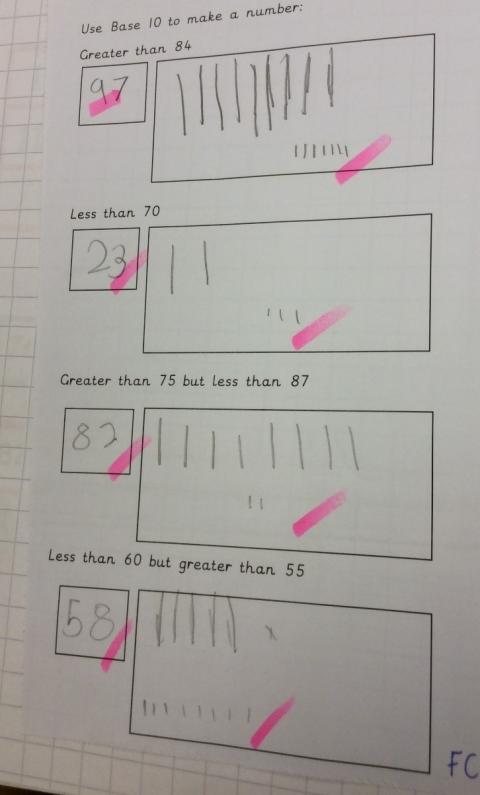
Context: Pupils had been exploring numbers up to 100. They had previously partitioned numbers in tens and ones, had practised counting forwards and backwards to 100. We then moved on to comparing numbers so we recapped the language greater than, less than, more than, equal to and children were able to complete stem sentences such as ____ is larger than _____, _____ is smaller than _____.
The pupil then went on to compare numbers. She was able to work independently to identify a number which fit the statement, this shows she is able to compare numbers within 100. She was then also able to represent her number using pictures of base 10 and she was verbally able to explain how many tens and how many ones her numbers had, this shows that she is aware what each digit of the two-digit number means.
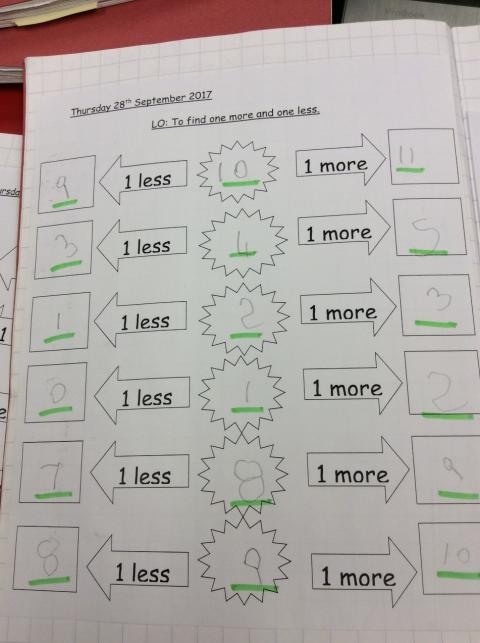
Context: Pupils used cubes to work out one more and one less than a given number.
The pupil made the number out of cubes and then took off one/ added one to work out one more and one less. They then completed the worksheet. They used the correct number formation and looked at the pattern e.g. 3 4 5 to check their answers
Pupils counted the dots to work out the original number and then wrote down one more and one less.
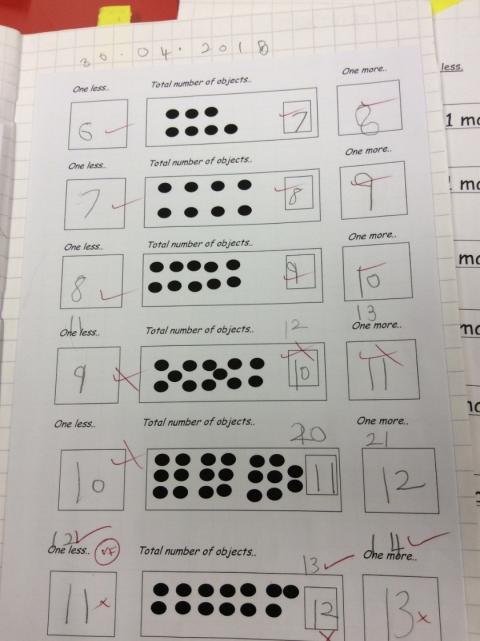
Context: The pupil was able to identify one more and one less but occasionally miscounted the dots so that the start number was incorrect. They did however correctly find one more and one less. This was an error not a misconception.
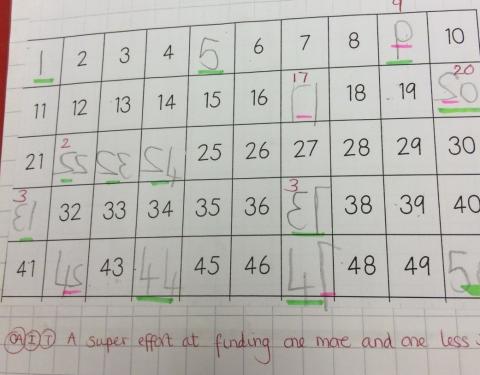
Context: Pupils worked on recognising numbers and looking at tens and ones and ordering numbers. They also used their knowledge of one more and one less to fill in the missing numbers.
Addition and Subtraction
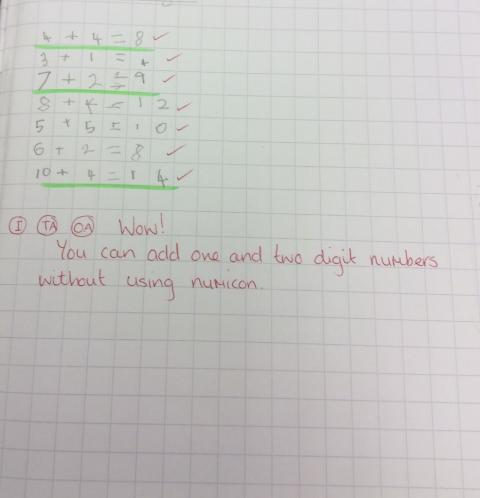
Context: Pupils worked on solving simple addition facts using one-digit numbers. Some students needed to use resources such as Numicon or cubes whereas others went onto adding a 1-digit number to a 2-digit number.
This pupil could solve these simple 1-digit addition questions mentally and independently, showing a secure knowledge of number and addition.
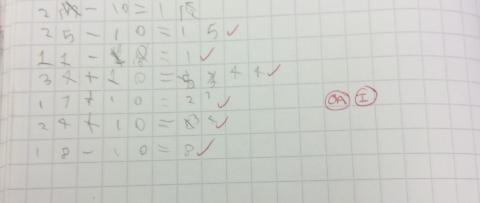
Context: Pupils worked on solving simple addition and subtraction facts adding 10 to a 2-digit number. Some students needed to use resources such as Numicon whereas others could complete mentally, the more able even went onto answering missing number problems such as __ + 10 = 33.
This pupil had a secure knowledge of both the addition and subtraction symbol. They could solve addition and subtraction questions mentally and independently, showing a secure knowledge of number and addition. They did make some mistakes at first however could self-correct showing a secure understanding of adding or subtracting 10.
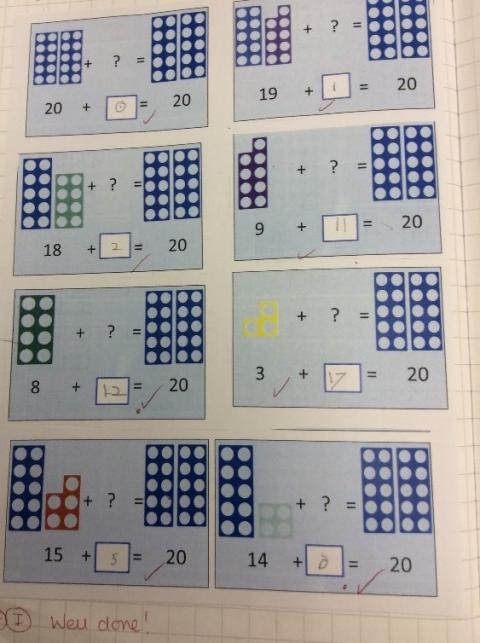
Context: Pupils worked on solving missing addition facts to 20. The children were expected to use and apply their knowledge of number bonds to 10 to solve questions to 20. Some students needed to use resources the physical resource such as Numicon to lay on top of each other whereas others could complete the questions mentally.
This pupil had a secure knowledge of both the addition symbol and how to calculate the inverse. They could solve the questions mentally and independently, showing a secure knowledge of number bonds.
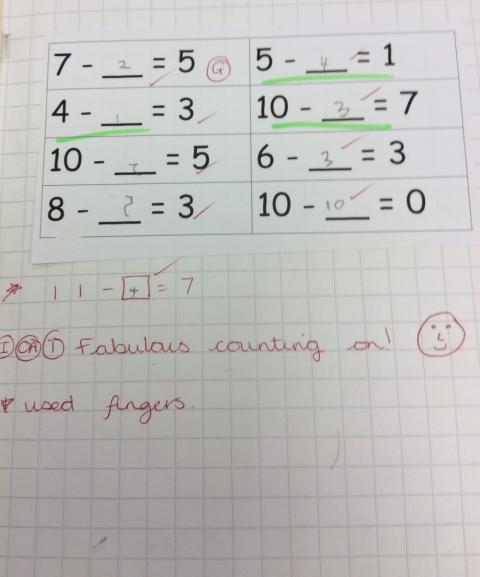
Context: Pupils worked on solving missing number subtraction problems, the numbers did not exceed 10. The children were expected to use and apply their knowledge of number to solve questions. Some students needed to use resources the physical resource such as Numicon to lay on top of each other whereas others could complete the questions mentally.
This pupil had to use their fingers to support them to find the answer. Initially the first question was guided through as a group and then they solved the remaining questions independently. This child could solve these problems with their fingers and solve some of the lower ones mentally such as 10 – 0 or 4 – 1. They were then able to show a deeper understanding of how to solve these problems by bridging through the 10 barrier.
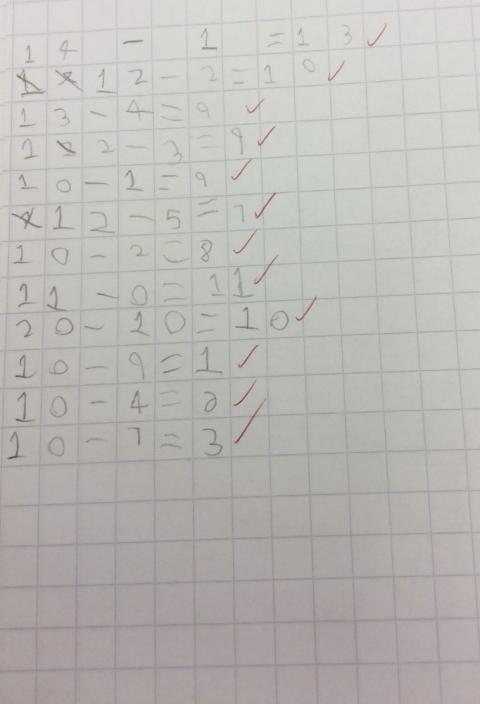
Context: Pupils worked on solving subtraction problems, focusing on their ability to cross the tens barrier. Some students needed to use resources such as Numicon to lay on top of each other or a number line whereas others could complete the questions mentally.
This pupil could solve these questions mentally and independently. They demonstrated a secure knowledge of number to 20, and their ability to subtract within that range.
Multiplication and Division
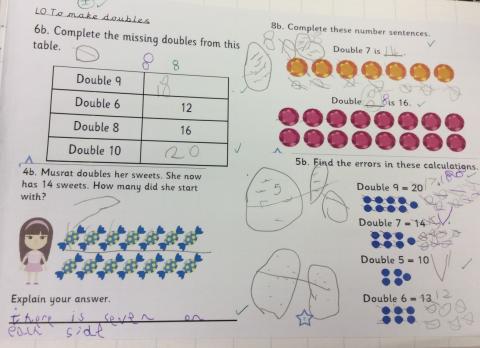
Context: The pupils had been practising doubles number facts in small groups using concrete objects, both Numicon and arrays. This was used as a daily input of 10 minutes per day before the start of each lesson throughout the previous week. The school works on what they call Key Instant Recall Facts – number facts that the children practise in order to ‘just know’ these by the end of the year.
The pupil worked independently at their table to answer a series of fluency and reasoning questions, applying their doubles number facts. They were able to check their doubling using the Numicon at their tables. They worked in pairs to complete the final question on their sheets (5b.) discussing where they saw errors in the calculations on their sheet. They were given sentence stems to support their discussion and were encouraged to say why they thought something.
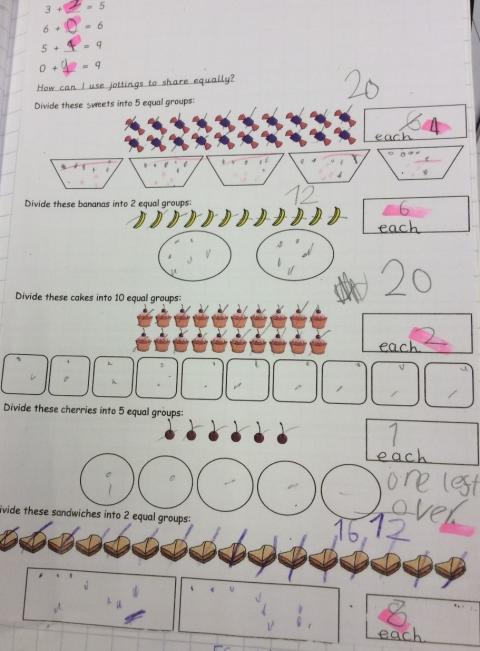
Context: Pupils had worked practically to use counters to help them share objects between places. They were able to do this accurately so we moved on to using pictorial representations to help them. We went through a couple of examples together before the children completed the task independently.
This pupil then worked independently to divide the different amounts into equal groups using dots to help her divide into groups. This child has demonstrated she knows that the groups have to be equal and she can share the whole amount between the groups.
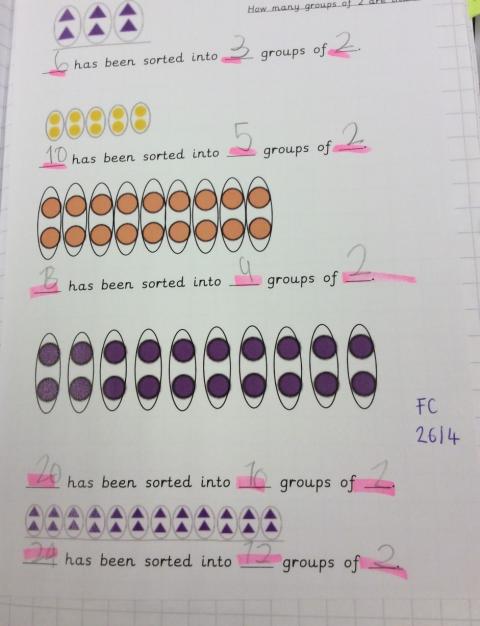
Context: Pupils had been looking at grouping. We started off working practically where children were given a number and they had to find out how many equal groups of 2, 5 or 10 they could make. They then had to identify how many groups had been made from visual representations, the teacher modelled a few examples on the board.
The pupil has shown that she is able to identify she can identify how many equal groups there are and also combine equal groups. This shows she is able to count in 2s, 5s and 10s.
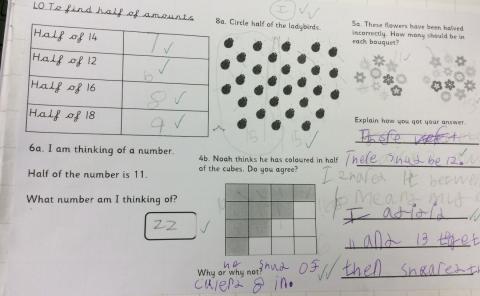
Context: The pupils had prior knowledge of doubles number facts through practising their Key Instant Recall Facts alongside explicit doubles work in class (see above). As a whole class the children were tasked with sharing objects into two groups. The children were reminded to ensure the groups were ‘equal.’
The pupil completed the sheet at their tables independently. They had white boards and pens on their tables and drew a line to halve their boards, creating two groups. They then halved the numbers on their sheet using the sharing method, drawing dots into each of their two groups on the white board.
The children were encouraged to discuss the problem solving and reasoning questions in talk partners to puzzle out the answers using what they already knew about number.
Fractions
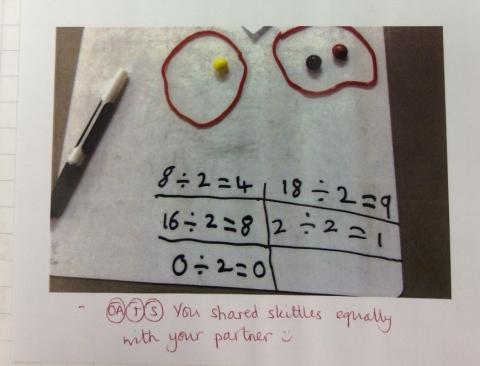
Context: The pupils practised sharing cubes as a whole class activity to find a half of an amount. We talked about fair/unfair/equal/unequal of which they a good understanding. Pupils then read out a number and counted out that amount of skittles. They worked together to share out the skittles into two equal groups. Pupils drew on their knowledge of equal and unequal to help with this.
The pupil worked with his partner to share out the skittles, initially by saying ‘one for you, one for me’ etc. He carefully counted each side to make sure that it was fair. He used ÷ to record his results. He had a secure understanding of the importance of the 2 parts being equal.
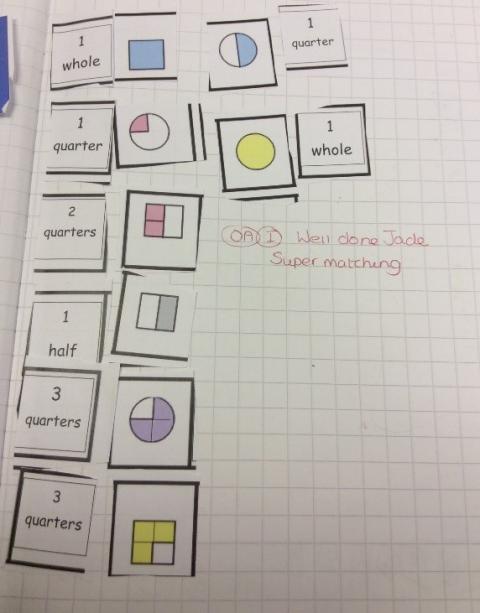
Context: Pupils had to match up the image with the answer, looking at the amount of the shape shaded in. Some students needed support from an adult or a working wall whilst others completed the work independently.
This pupil could independently pair up the amounts looking at halves, wholes and quarters. She could even verbalise the similarities between 2 quarters and 1 half.
Measures
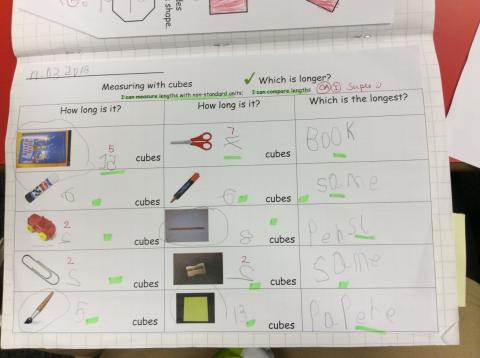
Context: We had a whole class discussion about length, and the importance of accurately measuring objects (starting from the bottom of an object, not overlapping etc.) In pairs they used cubes to measure the various objects on the sheet.
The pupil worked with a partner to measure the objects. He was careful to measure accurately and to line up the cubes next to the object to make it fair. He then had to work out which object was the longest which drew on his knowledge of number and place value. He reversed the occasional number but was secure in his understanding of which was the longest object.
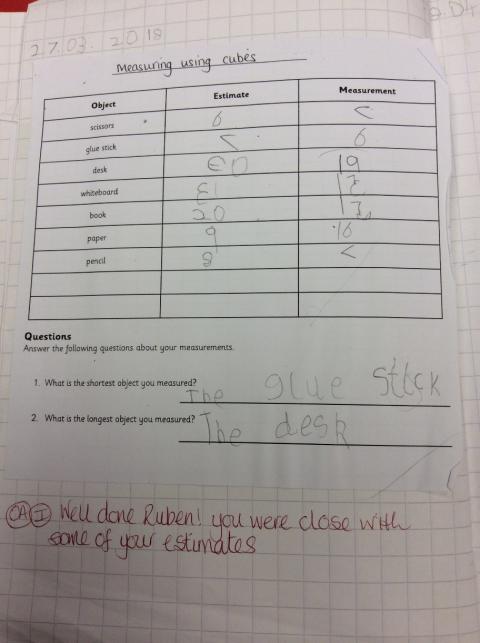
Context: This lesson built on their knowledge of the previous lesson. The children independently estimated the length of certain objects. We talked about the importance of a sensible estimate, using their knowledge of measuring and looking at the size of the cubes.
The pupil was comfortable accurately measuring the objects. He tried to use his previous knowledge when estimating and was able to justify his estimates when challenged. He was also able to identify the shortest and longest objects and say why. He reversed a number of the digits but used the correct place value.
Geometry
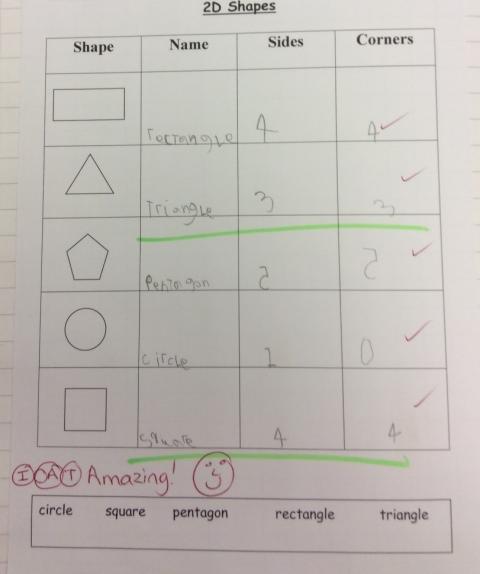
Context: Pupils had previous experience of 2d shapes, this piece of work asked for the children to call on this knowledge to solve these questions. Some students needed to use working walls, teacher or TA support to help them solve these questions.
This pupil could identify each 2d shape and their properties independently, demonstrating a secure understanding of 2d shapes.
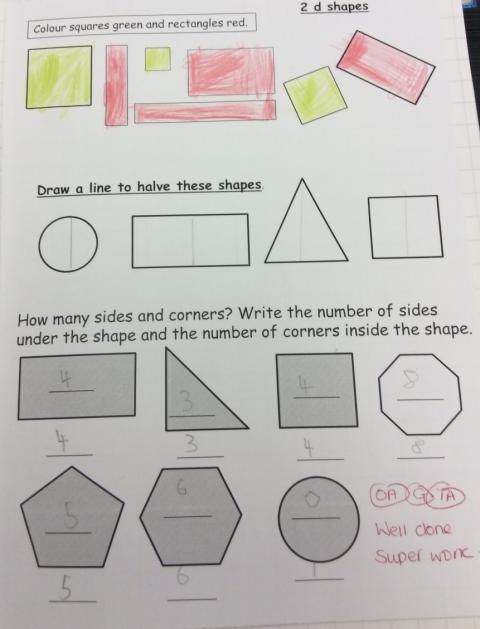
Context: Pupils had previous experience of 2d shapes, this piece of work asked for the children to call on this knowledge and apply it to ‘test’ like questions. Some students needed to use working walls, teacher or TA support to help them solve these questions.
Although this pupil was guided through the worksheet (needed help to read and understand each problem), they could identify each 2d shape and their properties independently.
